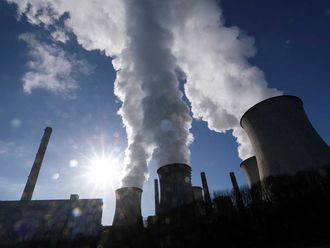For cash-rich investors looking for opportunities Indian equities could offer a good bet. After sulking in the wilderness for many months, as policy indecisions by the government drove the economy towards the brink, there is a turnaround in the works. It is still early days but the trend has clearly changed and confidence is returning. All the signs indicate the worst is truly behind us.
The Bombay Stock Exchange’s Sensex, a top-30 share index that is widely tracked by fund managers, rallied 7.6 per cent in September, its biggest monthly gain since January, driven by a slew of measures to boost foreign direct investment and temper government subsidies.
The benchmark rose to 18,762.74 on Friday -- its highest close in 14 months – and is likely to top 20,000 by December if not earlier.
Big foreign portfolio investors were the primary buyers in September, pouring in almost $3.6 billion according to provisional figures from the Securities and Exchange Board of India. Overseas funds have bought shares worth $15.9 billion since the start of January, and together with investments in debt, the total inflow in the year to date is nearly $20.7 billion. There is a good chance of equity inflows doubling in the December quarter.
“If you have money and a little patience, this is the time to start accumulating,” said equity salesman Mehul Patel. “The mood is firmly upbeat. The phones are ringing again.”
The trigger for the revival in market sentiment was a raft of reforms announced by the government in a span of 48 hours two weeks ago. The measures – opening up the $500 billion retail market to foreign supermarket chains, raising foreign ownership limits in domestic airlines and media, and raising state-controlled prices of diesel – were the first major policy initiatives by the ruling coalition in eight years.
It came after economic growth wilted to below 6 per cent from a heady above 9 per cent until a year and a half ago. The slowdown together with high inflation and a worsening fiscal health of the government had raised the heckles of ratings agencies who put New Delhi on notice for a possible downgrade to junk status. After keeping mum as the situation deteriorated, Prime Minister Manmohan Singh was jolted into action after foreign media termed him as an effectual leader.
Singh, an economist who made a name as the architect of economic reforms in the early 1990s when he was finance minister, does not have a political base. The 80-year-old is dependent on Congress party boss Sonia Gandhi, the Italian-born wife of assassinated former prime minister Rajiv Gandhi, a lady with a penchant for populist schemes and adverse to reforms.
The flurry of action has raised expectations Singh and Finance Minister P. Chidambaram, an able pro-market leader, would push ahead with long awaited opening up of the insurance and pension sectors.
There are also hopes the government would tighten the belt on subsidies, which have shot through the roof and have not really benefited the poor.
Prices of diesel are kept low on the pretext of helping farmers to drive their pump-sets and also because it’s the primary fuel for trucks and locomotives. However, diesel is increasingly consumed by cars and sport utility vehicles owned by the rich.
A government panel said in a report on Friday that India was on the edge of a “fiscal precipice” and should cut fuel, food and fertilizer subsidies to curb a budget deficit that could hit 6.1 per cent of gross domestic product in 2012-13.
“We cannot overemphasize the need and urgency of fiscal consolidation.
Growth is faltering and inflation seems to be embedded. The external payment situation is flashing red lights,” it said.
However, the current account deficit shrank by 24 per cent in the June quarter from a record high in the previous three months, helping India post a modest $0.5 billion balance of payments surplus from a deficit of $5.7 billion in January-March, data from the Reserve Bank of India showed. The current account deficit fell to $16.55 billion in April-June quarter from $21.76 billion in the March quarter.
Equity salesman Patel said expatriate Indians or foreigners investing in Indian shares stood to gain a bonus from the rupee’s appreciation.
Alongside the Sensex’s rally, the rupee strengthened 5.1 per cent in September to 52.85 against the dollar, posting the most rise since January and well off a record low of 57.32 hit in June.
The head of a foreign fund said private enterprise in India was rooted in strong footing and could stand up to global giants and even better them, but coherent government policies were needed to remove bottlenecks, especially in infrastructure such as power, roads and ports.
“Partisan politics and posturing is a huge millstone on India,” said the executive who did not want to be named because of the sensitive issue. “Indian businesses are resilient, adept adjusting to changing circumstances and quick to shift gears, but they are weighed down by bad policy and poor governance.”
— The writer is a journalist based in India.












